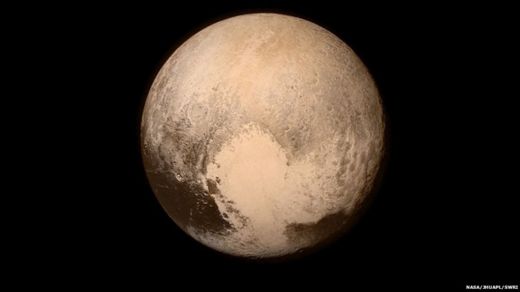
Credit: NASA/BBC
New Horizons completed its fly-by of Pluto at 7:49 AM US EDT on Tuesday, 14 July 2015. It passed Pluto at 30,800 miles per hour (49,600 kilometers per hour — 14 kilometres per second). After capturing all its data, New horizons began transmitting it back to Earth. Shown above is the best image to-date. More to come. Over the three billion mile distance to Pluto, the data rate is very low. 16 months will be required to transmit all of the data captured during the fly-by.
http://www.bbc.com/news/science-environment-33531811
http://www.theguardian.com/science/2015/jul/14/nasas-new-horizons-probe-makes-pluto-flyby-nine-years-after-leaving-earth / fly by completed whale’s tail polygonal feature band of complex patterns New Horizons interplanetary space probe launched NASA's New Frontiers program Applied Physics Laboratory Southwest Research Institute Alan Stern spacecraft launched study Pluto moons Kuiper Belt performing flybys Pluto system Kuiper Belt Objects KBOs New Horizons project Pluto 350 project Alan Stern Fran Bagenal Pluto Underground 1990 lightweight cost-effective spacecraft flyby Pluto construction several delays launch site New Horizons launched January 19, 2006, Cape Canaveral Earth-and-solar-escape trajectory Earth-relative speed 16.26 kilometers per second 58,536 km/h; 36,373 mph record highest launch speed of a human-made object from Earth brief encounter asteroid 132524 APL New Horizons Jupiter closest approach Jupiter flyby gravity assist New Horizons speed velocity general test returning data about its atmosphere moons magnetosphere post-Jupiter voyage hibernation mode preserve on-board systems brief annual checkouts first flyby of Pluto on July 14, 2015 /
No comments:
Post a Comment